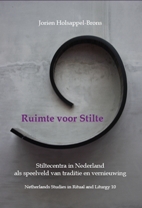Rooms of silence: from chapel to arts centre

‘Rooms of silence’ have been established throughout the Netherlands – spaces in public places such as hospitals, schools and airports where people can retreat for a moment. Jorien Holsappel-Brons has visited many of them in recent years. She has described quite a few and spoken with initiators and those using them. Their character has changed significantly over the years. ‘The users determine the nature of the rooms of silence.' Holsappel-Brons will be awarded a PhD by the University of Groningen on 23 September.
The term ‘room of silence’ stems from the 1970s. The first rooms of silence were established by churches to provide a ‘presence’ in society. They also began to appear in care institutions in the 1980s, as a means of expressing their denominational identity. The chapel-like nature of the first rooms of silence has changed greatly through the years. Not only the way they are furnished and decorated and how matters are organized has been subject to change, but also the ways they are referred to and discussed and the way they are used by visitors.
Candles and visitor’s books
In most rooms of silence visitors can light a candle or write something in a visitor’s book. ‘’These rituals are rooted in the Christian tradition, although individuals lend the objects their function and meaning.’ This can often be in a completely different context. There are also more and more universal symbols such as butterflies or stones and there are also self-conceived rituals. ‘The traditional objects no longer play a central role.’ The visitor’s books provide a great deal of insight into how visitors experience rooms of silence and use them. In addition to being used to write down prayers, they are also used for completely different messages. ‘People will write down all sorts of things. Everything from a short thank-you note to extremely long stories about all the misfortune that has befallen them.’ This is writing as a way of dealing with matters and attaining closure.
Multi-faith
More often than elsewhere, the Dutch have chosen multi-faith rooms of silence. There has been an increasing demand for Islamic prayer rooms in care and teaching institutions since the 1990s. ‘Here, spiritual carers are somewhat more focused on target groups. Hospitality is the leading concept, so Christian symbols and rituals aren’t necessarily considered to be paramount. A well-known example of a multi-faith room of silence is to be found in the University Medical Center Utrecht. There is a corner with a church bell, a cross and an icon of the Virgin Mary, but there is also an Islamic prayer corner. A bit further along is an ‘oriental’ corner with both a Buddha and a Shiva statue and the next corner contains a Star of David. The various corners surround a raised space bereft of religious symbols.
The role of art
The multi-faith approach is now giving way to an emphasis on aesthetics and experience in rooms of silence. Holsappel-Brons: ‘The role of art is increasing. A new notion of sacrality is taking shape, where the presence of religious attributes and symbols no longer takes first place – beauty does. The role of art has increased greatly, the multi-interpretable nature of abstract art in particular is important. Not only is art nice to look at – in a room of silence it also serves as a focus of contemplation. It evokes something in the viewer, whether it’s considered to be a spiritual experience or not.
Architecture
There has also been a change in architecture. Specific ritual functions and religious principles are no longer necessarily leading. There has been a return to the essence of architecture, where sacrality is the result of light, proportions and materials. Traditional shapes of spaces and traditional objects are still used but in new combinations and contexts.
Curriculum vitae
Jorien Holsappel-Brons (Vlissingen, 1983) studied Communication and Information Sciences at the University of Groningen, where she will receive her PhD from the Faculty of Theology and Religious Sciences. Her supervisors were Prof. A.L. Molendijk and Prof. P.G.J. Post, her joint supervisor was Dr J.E.A. Kroesen. The title of her thesis is Ruimte voor Stilte. Stiltecentra in Nederland als speelveld van traditie en vernieuwing (Room for Silence. Dutch rooms of silence as meeting grounds of tradition and renewal). The thesis is part of the Netherlands Studies in Ritual and Liturgy series, published by the Instituut voor Christelijk Cultureel Erfgoed (IVCCE – Institute for Christian Cultural Heritage) at the University of Groningen and the Institute for Liturgical and Religious Studies(ILRS) at Tilburg University. It can be ordered via lit.inst rug.nl.
Note for the press
More information: Jorien Holsappel-Brons, e-mail: j.c.brons rug.nl or tel. 050-363 7379
More news
-
15 September 2025
Successful visit to the UG by Rector of Institut Teknologi Bandung
